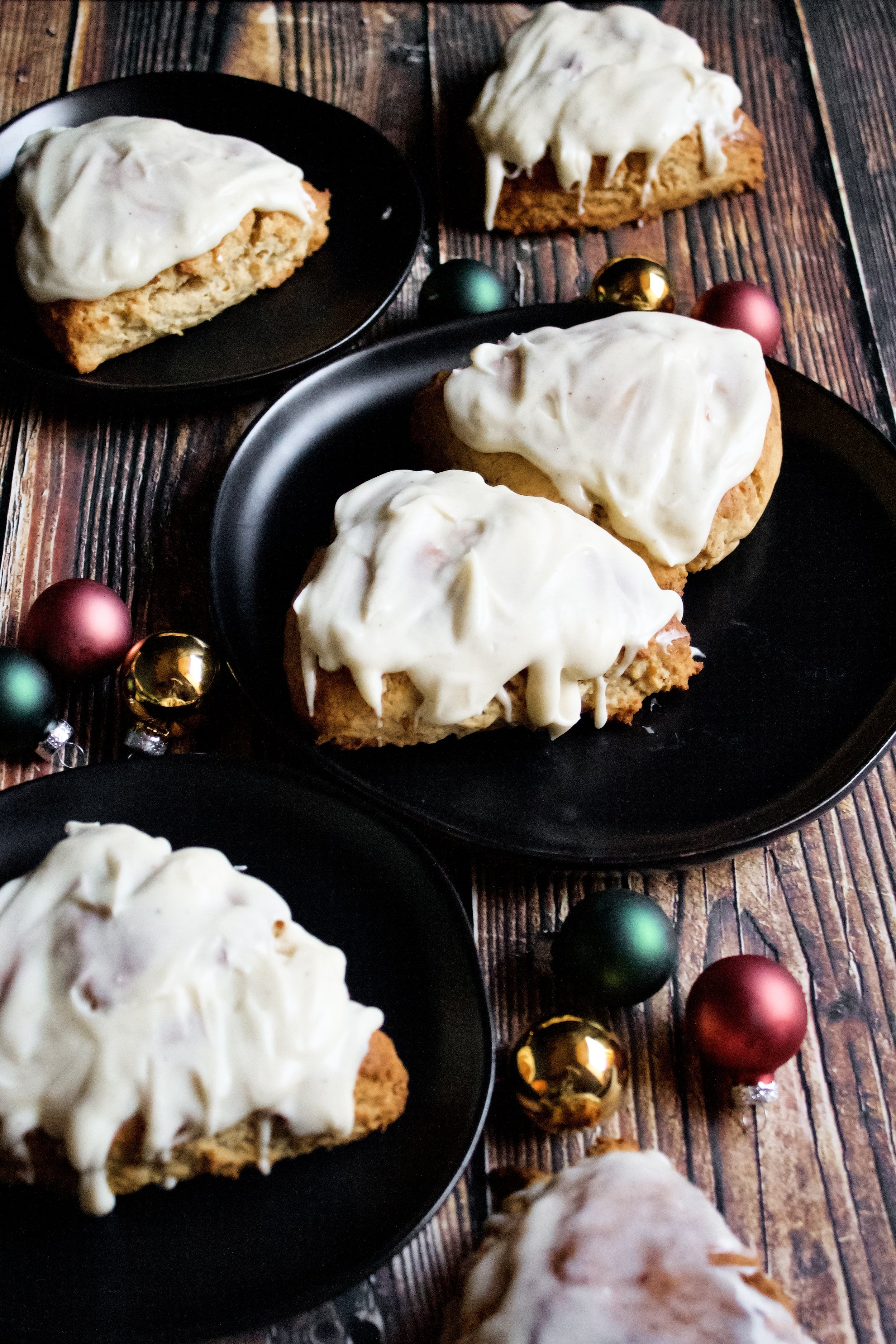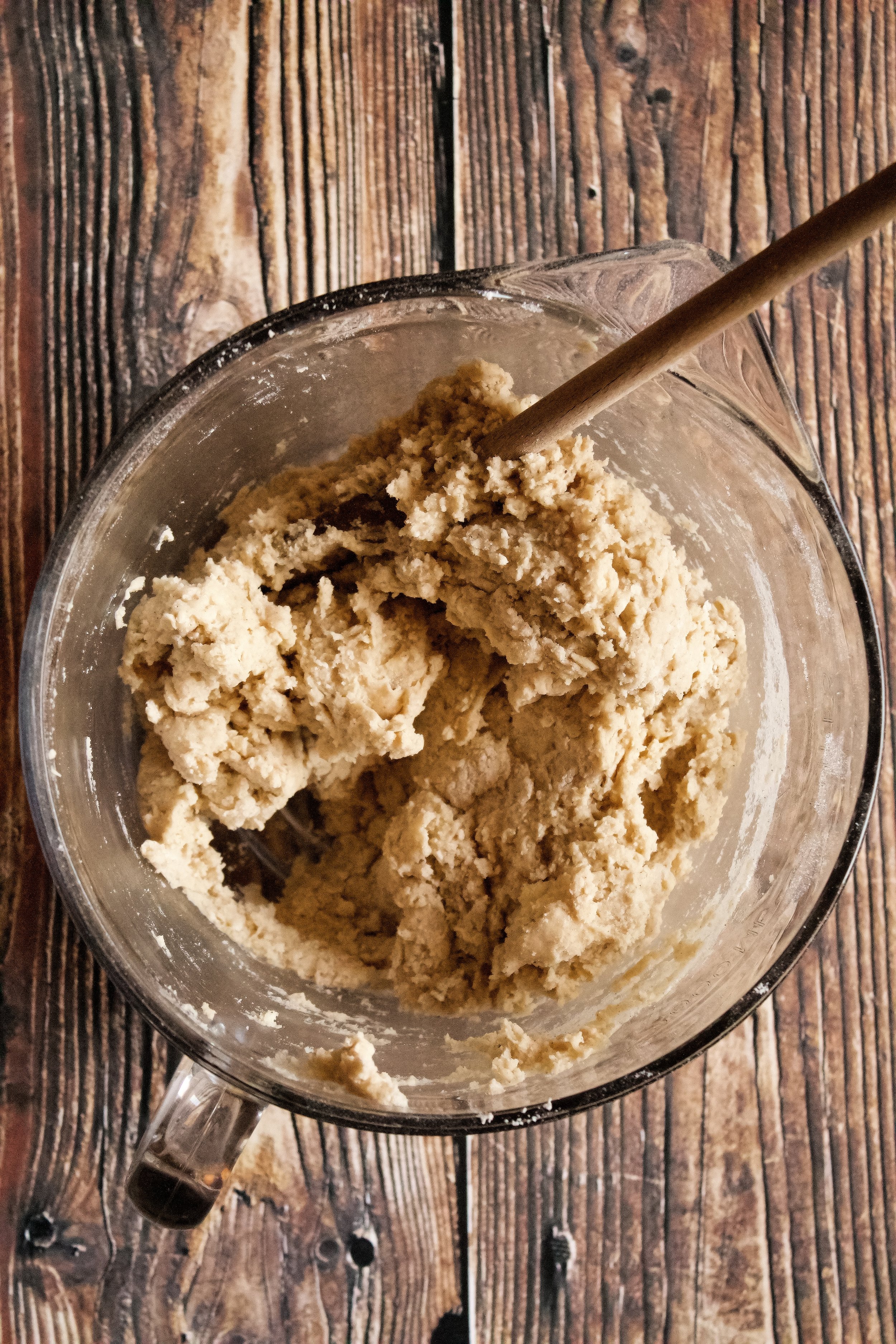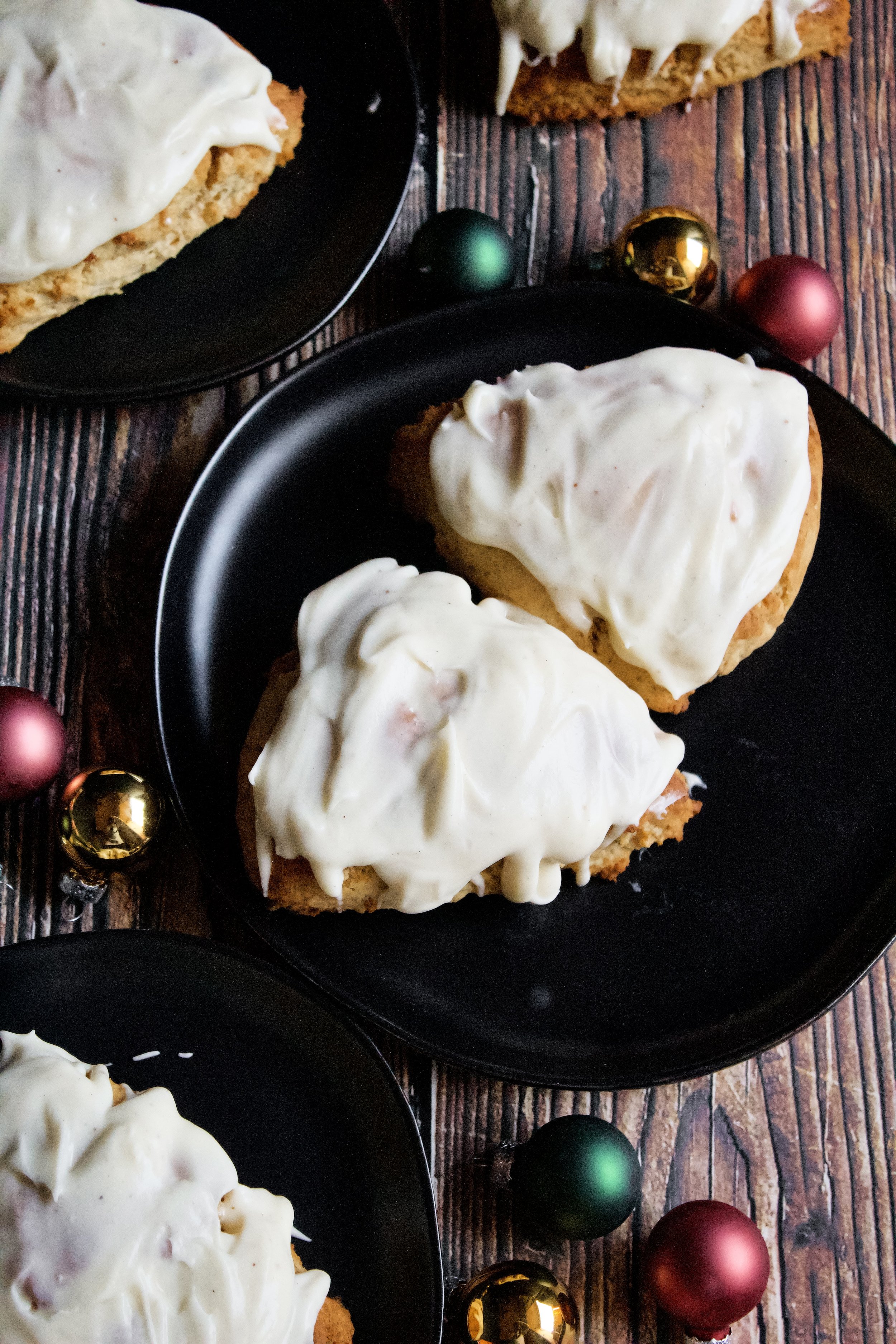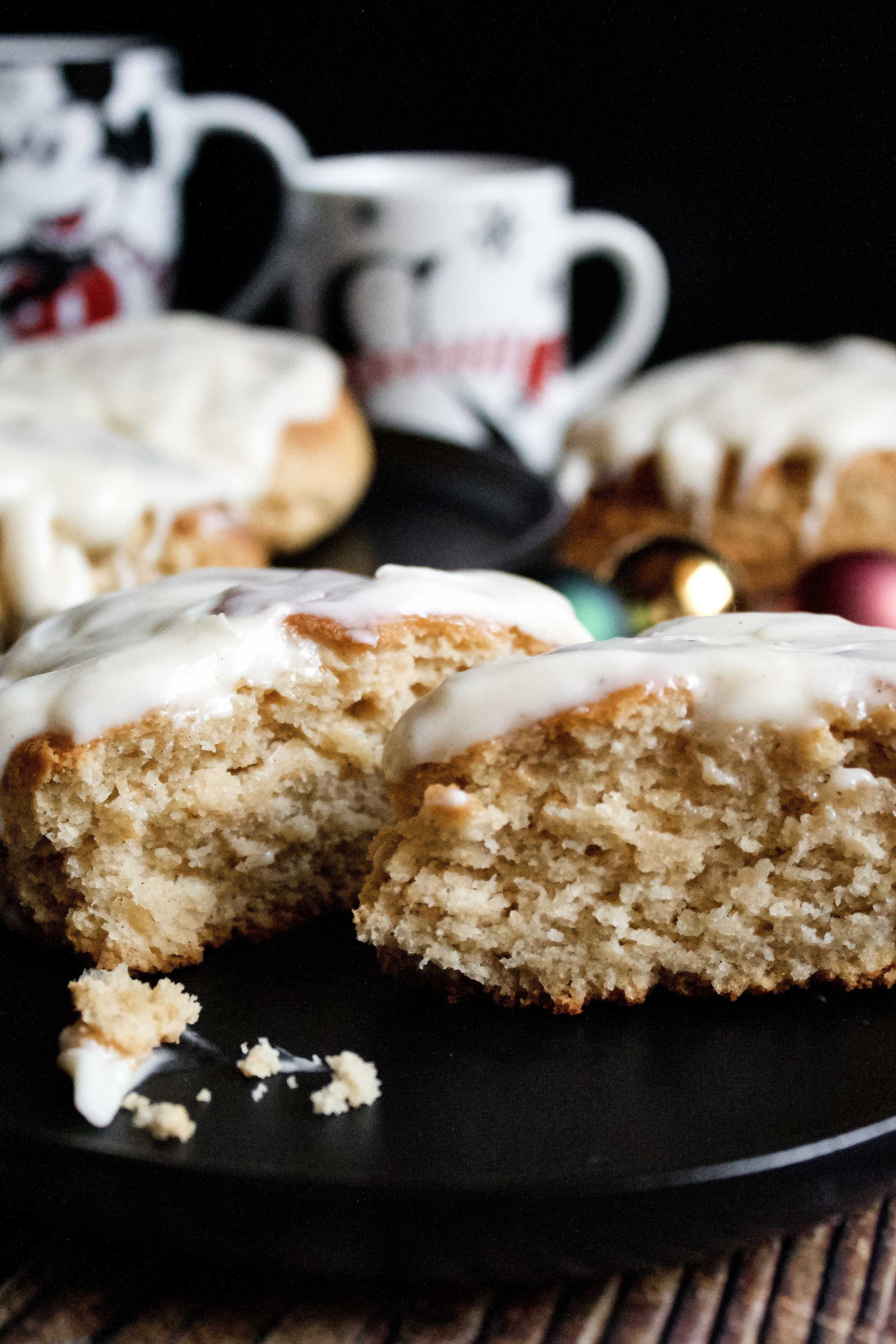Eggnog Scones
Perfectly tender, flaky scones made with real eggnog and topped with an eggnog spiced glaze. These are so simple to make and are bursting with Christmas flavors—making them a must for Christmas breakfast!
This post may contain affiliate links from which, at no additional cost to you, I may earn a small commission to keep this site running. Only products I myself would or do use are recommended.
Well, it’s turning out to be an interesting Christmas. We are currently planning a funeral for right after Christmas. My husband’s grandfather passed away this week. As sad as it is, and as hard as it is to happen at Christmas, he lived a very long, full life. He just turned 97, which is quite impressive on its own. And now he is with his beloved wife, whom we lost a year and a half ago. And in that time, we’ve lost a lot of other loved ones. It’s been rough. It’s been draining.
It’s making it suddenly hard to be cheerful and in the Christmas spirit.
So if that’s you right now—if the holidays are hard this year (or every year)—know you are not alone. Reach out to those around you, because the “Christmas spirit” isn’t about food or decorations or presents and it’s certainly not about feeling a certain amount or type of cheer.
It’s about people. It’s about relationships and love. That’s all you need right now.
Why this recipe works
Honestly, I don’t even quite know. This recipe was passed on to me by one of my old high school teachers who later became my coworker. She used to host these wonderful ladies teas at the end of the school year and would always make these. I’d heard the recipe was a secret, but when she retired, she was more than happy to give it to me. I regret not asking for it sooner!
Anyway, the biggest key here is the butter. I usually use my fingers to blend it, creating long bits of butter, similar to when making pie crust. Then the eggnog helps make these luscious and moist. The small bit of egg in the eggnog helps keep these together well and adds a bit of rise to them. The ingredients are perfectly balanced to hold together without being dry or dense.
And the flavors. I was winging it with these, hoping I wasn’t adding too much or too little of the cinnamon and nutmeg. I tend to have beginner’s luck with recipes (which I rarely repeat unless I write it down immediately), and this is one prime example. The flavors are perfect! Not too much, definitely not too little. Just a perfectly eggnog-y scone.
Key ingredients
Flour. This is key. Be absolute certain that you spoon then level the flour so you don’t pack it in. I’ve adjusted the original recipe because it came out wrong the first few times. Turns out it was written with the “just dunk and eyeball it” method of measuring flour, which packs in more flour than the gentle spoon-then-level method. So you can either weigh this or just measure carefully and gently.
Sugar. This is just enough to make these a little sweet so you can pair them with any topping.
Baking powder. Make sure it’s fresh. This helps create a bit of rise without making these a cookie.
Salt. Sea salt is ideal!
European style bitter. This has less water than sweet cream, so it’s ideal for a flakey scone. Be sure it’s nice and cold, and follow the notes about what to do if it gets too warm when you blend it in.
Eggnog. Nope. This is not a health food. But also, does that really matter? When you taste these, you’ll agree.
Cinnamon. Just a teaspoon in both the scones and the glaze brings out a perfect eggnog flavor.
Nutmeg. Again, this is in the scones and glaze to add some eggnog flavor.
Powdered sugar. Also known as icing or confectioner’s sugar. If yours is clumpy, be sure to sift it (humidity can cause this).
Heavy cream. Used only in the glaze for this recipe. You can sub cream, half and half, or milk, but you’ll need much less.
How to make eggnog scones
1. Blend dry ingredients. This can be done with a whisk. I also suggest sifting it all, even though it’s not in the original recipe. I think it gives a softer texture and helps the baking powder distribute better.
2. Cut in very cold butter. Use unsalted, European style here. If the butter becomes warm (especially if it feels greasy), put the whole bowl into the fridge for 10 minutes to help re-chill the butter. For this batch, I used a pastry blender, but I usually just use my hands.
3. Stir in eggnog. Only mix until you see no more dry bits of flour. And be sure the butter is nice and cold still when you add this.
4. Shape and bake. Pat into a 6” flat disc then cut into 6 triangles. You can also make this into a rectangle and make 6 square scones, but I like the traditional triangle that I’m used to.
5. Mix glaze. Doing this while the scones cool slightly is ideal. You want to serve them warm, but you don’t want to glaze them piping hot.
Enjoy!
Tips and FAQ’s for this recipe
Do I have to use my hands?
No, but I do think it makes a noteworthy difference in this recipe. Although, my hands have been SO dry lately, so I caved and used a pastry blender this time. #noshame I add in a freezing step to account for the warmth of your hands melting the butter slightly. If you do use a pastry blender or other butter blending method, just be sure you don’t blend the butter too small (the dough should not resemble wet sand—that means you’ve over-mixed the butter).
How do I know if the butter is too warm?
If the butter is greasy or shiny or soft, it’s too warm. It should be very cold when you use it, which is why I have you leave it in the fridge until needed. If your butter got too soft while blending, you can freeze it a few minutes longer, until it’s very firm once again.
Can I use an egg wash?
Yes! I’m actually not an egg wash fan, so I didn’t bother this time. I’ve used milk and also just nothing for these (and most of my desserts), so it’s up to you. An egg wash is pretty standard on scones, but since we’re glazing these, it’s not necessary. So, it’s entirely up to you!
Can I cut the disc into more pieces?
Sort of. Six wedges is ideal, but you could do 8 (it is easier to divide evenly that way). But avoid cutting these into more wedges, as they won’t bake the right way.
I have made these into mini scones, but that requires two slightly shorter discs that are also cut into 6 pieces. If you do want to go that route, make two equally sized discs of about 3/4 inch tall. Cut them into 6 pieces (not 8—this will not work). Also be sure to freeze the dough at least 10 minutes before adding the heavy cream, as mini scones are prone to spreading.
Do I have to make the glaze?
Not if you don’t want to, but I do think it adds a great flavor and creaminess. Plus, it helps keep the scones moist for longer. However, it’s definitely optional, so feel free to leave it off. If you do, I’d suggest brushing the scones with an egg wash and sprinkling them with some sugar before baking.
My tools
Here are my must-have tools to make these scones. Affiliate links provided.
Silicone baking mats (or parchment paper)
Pastry blender (or your fingers—I only use a pastry blender when I’m tired of dry hands)
Eggnog Scones
- prep time: 10-15 minutes
- bake time: 23-27 minutes
- total time: 42 minutes
servings: 6-8
Ingredients:
for the scones
- 2 ¾ cups (374g) all-purpose flour, spooned and leveled
- 2 teaspoons (10g) baking powder
- ½ teaspoon (3g) salt
- 1 teaspoon (3g) ground cinnamon
- ¼ teaspoon (1g) ground nutmeg
- ½ cup (100g) granulated sugar*
- 12 tablespoons (170g) very cold, unsalted European style butter, cut into cubes
- 1 cup (240g) cold eggnog
for the glaze
- 1 cup (130g) powdered sugar
- ¼ teaspoon (1g) ground cinnamon
- 1-2 dashes nutmeg
- 2-3 tablespoons (30-45g) heavy whipping cream (or half as much milk)
- optional: ½ teaspoon (1g) pure vanilla extract
Instructions:
- Preheat your oven to 375F/190C. Dice your butter and place back in the fridge until ready to use.
- Sift and whisk together the flour, baking powder, and salt in a large bowl. Sifting isn’t necessary, but it helps create a more tender crumb. Whisk in the sugar.
- Using your (clean) fingers (or a pastry blender, but I think fingers work best here), blend the butter in, smashing the cubes into the flour. You want the pieces to be no larger than small peas or shredded parmesan cheese–but a lot of the butter will be even smaller by this point. Use a rubber spatula to scrape any large bits of dough or butter stuck to your hands back into the bowl.
- At this point, freeze or refrigerate the dough for 5-10 minutes. This is my own little addition to the recipe, but it really makes a difference. Smashing the butter with your hands or even a pastry blender still warms it up. Freezing the dough for just a few minutes resolidifies the butter and ensures it won’t melt too quickly or cause the dough to spread during baking.
- Stir in the cold eggnog. Be very careful to only stir until the flour is combined. If you see a few bits of dry flour, you can pat those into the dough in the next step.
- Turn the dough out onto a clean surface and gently pat it into a disc at least 1” thick (avoid having it significantly thicker). Cut into 6 wedges. You can cut it into 8, but should do no more than that. Double the recipe if you’d like to make a larger batch.
- Arrange the wedges on a parchment lined baking sheet, at least 2” apart.
- Bake for 23-27 minutes (less if you cut your disc into 8 pieces), until matte in appearance and the tops begin to turn golden.
- While the scones cool, make the glaze. Mix all glaze ingredients together until smooth. Taste, adding more spices as needed. If the glaze is too thin, add more powdered sugar. If it is too thick, add more cream.
- Drizzle or spread over slightly warm scones. You can also glaze cooled scone then reheat them briefly before serving.
Enjoy with your morning coffee!
Store leftovers in an airtight container. They should last 3-5 days, if well-sealed. It’s highly recommended to warm leftovers in an oven or toaster oven.
*If your sugar is larger grain (such as raw), grind it in a food processor before using.























